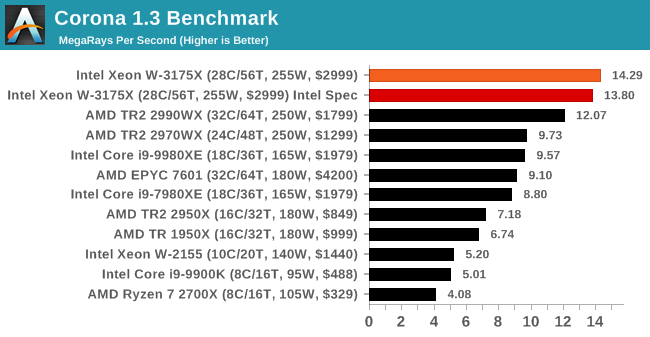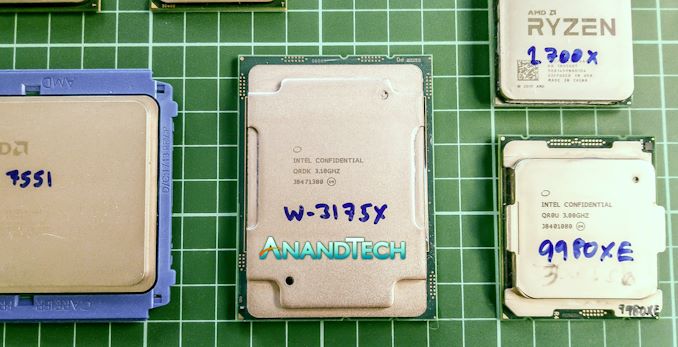The Intel Xeon W-3175X Review: 28 Unlocked Cores, $2999
by Ian Cutress on January 30, 2019 9:00 AM ESTConclusion: Price Makes Perfect
When you buy a system, ask yourself – what matters most to you?
Is it gaming performance?
Is it bang-for-buck?
Is it all-out peak performance?
Is it power consumption?
Is it performance per watt?
I can guarantee that out of the AnandTech audience, we will have some readers in each of these categories. Some will be price sensitive, while others will not. Some will be performance sensitive, others will be power (or noise) sensitive. The point here is that the Xeon W-3175X only caters to one market: high performance.
We tested the Xeon W-3175X in our regular suite of tests, and it performs as much as we would expect – it is a 28 core version of the Core i9-9980XE, so in single threaded tests it is about the same, but in raw multi-threaded tests it performs up to 50% better. For rendering, that’s great. For our variable threaded tests, the gains are not as big, from either no gain at all to around 20% or so. This is the nature of increasing threads – at some point, software hits Amdahl’s law of scaling and more threads does nothing. However, for software that isn’t at that point, the W-3175X comes in like a wrecking ball.

For our graphs, some of them had two values: a regular value in orange, and one in red called 'Intel Spec'. ASUS offers the option to 'open up' the power and current limits of the chip, so the CPU is still running at the same frequency but is not throttled. Despite Intel saying that they recommend 'Intel Spec', the system they sent to us to test was actually set up with the power limits opened up, and the results they provided for us to compare to internally also correlated with that setting. As a result, we provided both sets results for our CPU tests.
For the most part, the 'opened up' results scored better, especially in multithreaded tests, however Intel Spec did excel in memory bound tests. This is likely because in the 'opened up' way, there is no limit to keeping the high turbo which means there could be additional stalls for memory based workloads. In a slower 'Intel Spec' environment, there's plenty of power for the mesh and the memory controllers do deal with requests as they come.
Power, Overclockability, and Availability
Two-and-a-half questions hung over Intel during the announcement and launch of the W-3175X. First one was power, second was overclockability, and two-point-five was availability.
On the power side of the equation, again the W-3175X comes in like a wrecking ball, and this baby is on fire. While this chip has a 255W TDP, the turbo max power value is 510W – we don’t hit that at ‘stock’ frequency, which is more around the 300W mark, but we can really crank out the power when we start overclocking.
This processor has a regular all-core frequency of 3.8 GHz, with AVX2 at 3.2 GHz and AVX-512 at 2.8 GHz. In our testing, just by adjusting multipliers, we achieved an all-core turbo of 4.4 GHz and an AVX2 turbo of 4.0 GHz, with the systems drawing 520W and 450W respectively. At these frequencies, our CPU was reporting temperatures in excess of 110ºC! This processor is actually rated with a thermal shutoff at 120ºC, well above the 105ºC we see with regular desktop processors, which shows that perhaps Intel had to bin these chips enough that the high temperature profile was required.
On the question of availability, this is where the road is not so clear. Intel is intending only to sell these processors through OEMs and system integrators as part of pre-built systems only, for now. We’ve heard some numbers about how many chips will be made (it’s a low four-digit number), but we can only approximately confirm those numbers given one motherboard vendor also qualified how many boards they were building.
One of Anand’s comments I will always remember during our time together at AnandTech was this:
“There are no bad products, only bad prices.”
According to OEMs we spoke to, initially this processor was going to be $8k. The idea here is that being 28-core and unlocked, Intel did not want to consume its $10k Xeon market. Since then, distributors told us that the latest information they were getting was around $4500, and now Intel is saying that the recommended consumer price is $3000. That’s not Intel’s usual definition of ‘per-1000 units’, that’s the actual end-user price. Intel isn’t even quoting a per-1000 unit price, which just goes to substantiate the numbers we heard about volume.
At $8000, this CPU would be dead in the water, only suitable for high-frequency traders who could eat up the cost within a few hours of trading. At $4500, it would be a stretch, given that 18-core on Intel is only $2099, and AMD offers the 32-core 2990WX for $1799 which surpasses the performance per dollar on any rendering task.
At $2999, Intel has probably priced this one just right.
At $2999, it's not a hideous monstronsity that some worried it would be, but instead becomes a very believeable progression from the Core i9-9980XE. Just don’t ask about the rest of the system, as an OEM is probably looking at a $7k minimum build, or $10k end-user shelf price.












136 Comments
View All Comments
abufrejoval - Wednesday, January 30, 2019 - link
So with the limited edition production numbers, quite clearly the price can be symbolically low, just so Intel can claim bragging rights: They are not interested in satisfying market demands, especially since far too many workstation and server customers might switch over from a Xeon Scalable offering, they just want to claim victory... everywhere... including 10nmJust pathetic!
And honestly, you shouldn't even report about it. Your mission is to inform consumers on products they can buy. If consumers cannot buy it, you should treat it very, very differently, if at all.
You're just being abused by Intel to push a brand that suffers for reasons.
SH3200 - Wednesday, January 30, 2019 - link
This product cannibalizes half the current Xeon lineup as it provides ecc/rdimm at a fraction of the cost. I’d be amazed if FSI customers don’t prebuy every single one ever made before it even hits the public.br83taylor - Wednesday, January 30, 2019 - link
I find it odd Ian is happy to run and report benchmarks with this processor going against Intel recommendation for bios settings, yet would not do it for the AMD processors with their PBO setting. Both of which seem to do very similar things. Letting the 2990WX run with PBO would give it a much fairer chance against this.GreenReaper - Thursday, January 31, 2019 - link
It's not unressonablr to test the system as given to you, especially when it is provided as a complete system, so may represent what end-users get. That said, it seems like he kinda called that out in the sideways manner by highlighting the fact that the system Intel had shipped to him was not actually using those specifications.outsideloop - Wednesday, January 30, 2019 - link
This reminds me of the FX-9590. Massively overclocking silicon to keep up. Except now, the shoe is on the other foot.wow&wow - Wednesday, January 30, 2019 - link
Xeon W-3175X: $2999+$1500= $4499Ryzen TR 2900WX: $1799+$300= $2099
Is Intel trying to market it for “stupids” or those whose left brains being not right and right brains having nothing left :-D
ksec - Wednesday, January 30, 2019 - link
I think we need some new innovation in Thermal Cooling, how we could cool more with less, ease and cheaper. We pushed to near 600W for CPU and GPU alone.mapesdhs - Saturday, February 2, 2019 - link
Ye cannae beat the laws of physics. :D Thermal density is a hard problem. Check out AdoredTV's video on the subject, it explains things nicely.The_Assimilator - Wednesday, January 30, 2019 - link
This is Pentium 4 days all over again.bananaforscale - Thursday, January 31, 2019 - link
Kitty approves of heat output.